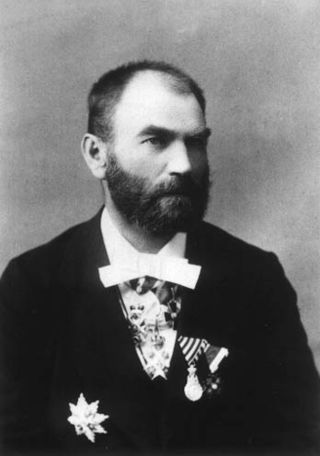
Vladimir Ćorović was a Serb historian, university professor, author, and academic. His bibliography consists of more than 1000 works. Several of his books on the history of Serb, Yugoslav, Bosnian and Herzegovinian uprisings are considered to be definitive works on the subject.

Svetomir Nikolajević was a Serbian writer, politician, scholar and Nobel Peace Prize candidate.

Ipokrat "Vladan" Đorđević was a Serbian politician, diplomat, physician, prolific writer, and organizer of the State Sanitary Service. He held the post of mayor of Belgrade, Minister of Education, Prime Minister of Serbia, Minister of Foreign Affairs and Envoy to Athens and Istanbul.

Milan Đakov Milićević was a Serbian writer, biographer, publicist, ethnologist and one of the founders of the Association of Writers of Serbia.
Konda Bimbaša;, fl. March 1804–d. May/June 1807) was an Albanian in Alija Gušanac's Dahije detachment in the Sanjak of Smederevo who switched sides to the Serb rebels during the First Serbian Uprising, proclaimed a hero for his efforts in the Siege of Belgrade (1806).
Cincar Marko Kostić was a Serbian aristocrat and diplomat. He served as vojvoda of Soko nahiye and duke of Šabac, and was one of the leaders of the First Serbian Insurrection.

Jovan Simić Bobovac was a Serbian politician, who began his career as knez during the Ottoman period, participated in the Serbian Revolution (1804–17), and served as the President of the Serbian Supreme Court. He was one of the closest collaborators of Prince Miloš Obrenović.
Radič Petrović, known as Captain Radič, was a Serbian Revolutionary commander (vojvoda), earlier a Military Frontier guard and volunteer in the Austro-Turkish War (1787–91).

Stevan Magazinović was a Serbian politician and judge. He was minister and representative of the Prince Miloš Obrenović, at a time when Serbia was an autonomous province within the Ottoman Empire.
Đorđe Protić was a politician and judge.
Mica Brka-Krajević distinguished himself in several battles in the Serbian Revolution, from 1804 to 1813, particularly at Mačva. National Serbian ballads name Krajević as one of the many heroes of the revolutionary wars. He died fighting the Turks alongside Hajduk Veljko.
Pavle Cukić was a Serbian duke and a revolutionary from the time of the First Serbian Uprising and Second Serbian Uprising.
Atanasije "Tanasije" Čarapić or Atanasije "Tanasko" Čarapić was a voivode and Serbian revolutionary.
Živko Dabić was a captain (boluk-bashi) in the First Serbian Uprising under the command of his father-in-law Jakov Nenadović. Also, he was a representative of his district in the first Serbian national assembly held in Ostružnica near Belgrade in April and May 1804.

Nikola Ziković or Nikola Šišmanović was a Serbian revolutionary hero who participant in the First Serbian Uprising and Second Serbian Uprising.
Aleksa Vukomanović was a historian and professor of the Lyceum in Belgrade.
Archimandrite Arsenija Gagović is remembered as the renovator of Piva monastery and one of the major players in the liberation of Serbia from the Ottoman Empire before and during the First and Second Serbian Uprising. Folk songs and tradition speak of him among the faithful and the clergy as Arsenije Pivski who travelled to the Holy Land.

Stanko Arambašić was a Serbian Free Corps commander who liberated parts of Serbia during the Austro-Turkish War (1788-1791).

Svetozar Andrejević was a Serbian merchant, philanthropist, and member of Beogradska Trgovačka Omladina.
Ignatije Bjelić was a subordinate to a famous voivode and military leader Stojan Čupić and rose to the rank of captain in the First Serbian Uprising.








